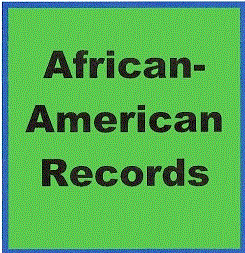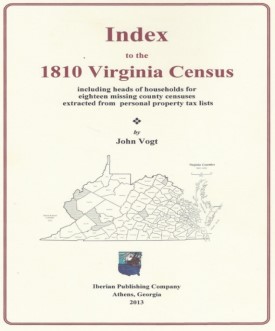






 
Home
Reference
Census Records
Military
African-American
Other States
New Titles
E-BOOKS
FREE SHIPPING IN USA
Iberian Publishing Company's 2020 On-Line Catalog:
Index to the 1810 Virginia Census
For a better understanding of county boundary changes, see our new section Virginia in Maps
Iberian also has hundreds of titles in e book (PDF) format!! Click here for a complete online catalog of available titles

 INDEX TO THE 1810 VIRGINIA CENSUS INDEX TO THE 1810 VIRGINIA CENSUS
by John Vogt. 2013, 8x10, xv, 392 pages. Paperback; printed on acid-free stock.
Virginia’s 1810 Census as an important genealogical tool.
The census was never designed as a genealogical tool. Yet few, if any, records reveal as many details about individuals and families as do the U.S. federal censuses. The population schedules are successive "snapshots" of Americans that depict where and how they were living at particular periods in the past. Because of this, the census is often the best starting point for genealogical research after home sources have been exhausted.
Article I, section 2, of the U.S. Constitution required only that the censuses gather aggregate information on the whole number of free persons, including those bound to service and excluding Indians not taxed, and three-fifths of all "other persons," a euphemism for slaves. After the 13th amendment (1865) to the U.S. Constitution abolished slavery, the 14th amendment, section 2, eliminated the separate slave category in the census. Yet the 1810 Virginia census has become one of the first documents a genealogist searches when looking for ancestry in the early nineteenth century. This is obvious when one examines images of the original manuscript, with its frequent marginal check marks, ticks, and underlining that were inserted in earlier years prior to the National Archives’ access restrictions and the microfilming projects of the mid-twentieth century; the original census sheets were used and reused for family searches well into the twentieth century, until microfilm copies were made available. Today the microfilm is the primary medium for their research, and companies provide digital images of these pages online. Still, it takes a trained eye with experience in reading court-hand and early cursive styles to sort through this material.
Why should I bother?
The argument is often put forth “Why should I bother with a researched, printed version of a particular census, when it is all available online? While the Internet opens vast new avenues for genealogical research, it is replete with errors. There is no better example than the digital images provided by Ancestry for Virginia’s census, with a “helpful” transcript of the names at the bottom for many of the pages. As a test, this writer sampled several of the pages with transcripts for accuracy in one county - Surry. On folio 609 for Surry, which is a very clear, easy-to-read sheet, the first names in Ancestry’s transcription are: 1) Grey M. Harrison; 2) William Hoops; 3) John H. Howard; 4) John Hulburd; and 5) John Harby. The true names of these individuals were : 1) Benj.a [Benjamin] Harrison; 2) William Hicks, S.r; 3) John H. Harrison; 4) John Hubbard; and 5) John Hardy. In all, out of 29 entries on this folio, 12 were mis-transcribed.
In the case of a county like Bedford, the manuscript is in such poor condition, with fading, water damage, and missing edge portions, that it is virtually unreadable via computer-generated images. And Bedford is not alone among Virginia counties with these and similar problems of readability. Included among this list are Bath, Accomack, Campbell, Rockbridge, and several others.
Another argument often heard is “My ancestors left there long before 1810. I don’t need it.” Still, one can find the concentrations of the family name in 1810 and use this as a clue to trace your Virginia families back to earlier decades.
Space and Time: Tracking your ancestor’s movements.
With a census, the researcher can place an ancestor in space and time as a starting point for research both forward and backward through history. This is especially important in Virginia, because the decades immediately following the Revolution was a time of both economic and political upheaval for Virginia. The paper currency of the Revolution was worthless and traded at less than one percent of its face value; hard currency was virtually non-existent, and the economy had devolved to that of bartering. It would be decades before a full recovery ensued. The political structure of the state also was in flux. Kentucky County was detached and became a state in its own right; two dozen new counties were created out of the older larger political units, especially in the western region. Thus, an ancestor who was born during the 1770s in Botetourt County and who was still living in his same home might find himself in the county records for Fincastle County from 1772 to 1777, or in Montgomery County, formed from Fincastle in 1777, or in the portion of Montgomery which became Wythe County in 1790, or finally in Tazewell County by 1800. A quick check in the statewide census index would assist greatly in a search for this family.
Similarly, the western population of Virginia was on the move, both within the state and along the great migration routes southward and westward. Again the census might indicate whether or not ancestors still resided within the state or their absence.
Individuals with the same name.
Occasionally, the census taker’s notations can assist in untangling multiple persons with the same name. In many, but not all, instances when the enumerator recognized a name identical to that of a previous entry, some attempt was made to distinguish between them. In Accomack County, for example, similar-named persons might have the abbreviations “BS” [Bay Side], “SS” [Sea Side], or the abbreviation of an adjacent creek appended to their line entry. In most other counties, water courses were used to distinguish between similar names. In Halifax County, for example, Thomas A. Dance’s line carries the notation “A.Creek”, i.e., Aaron’s Creek, indicating his residence on the eastern edge of the county. A few entries are more descriptive. In the 1810 Pittsylvania personal property tax listing, which was used by this writer as a substitute census for a missing county census, James Turley “one eye”, William Shelton “red head”, and John “Cutfinger” Watson lend a bit of color to the list.
Finding relatives among neighbors.
The individual county enumerator was left to his own devices as to the order of entry for his county census. Of the eighty-one surviving county and city censuses, forty-eight were entered as each family was contacted. In a few instances, the entries were arranged in the order of visitation. In thirty-one of the remaining counties, the enumerator rearranged the data into rough alphabetic letter groupings; and in Warwick County, the enumerator chose to use an ancient European style of organization. The county census is arranged by first-name. Thus, all the Johns are together, all the Michael’s, and Richard’s, etc.
The first group of entries, arranged in a rough spatial order as the enumerator traveled from home to home in his district, can be very valuable for the genealogical researcher. With this group, one can place an ancestor in space as well as time, and his/her immediate neighbors (and potential related families) offer an avenue of investigation. It can reveal possible related groups: For example, in Hampshire county, where very few free blacks were reported, there was a cluster of three families ( Esther -----, Dido Hamilton, and Clem Monday) living adjacent to one another on the South Branch of the Potomac River (Hampshire, fol. 793; [VDL, Hampshire, p.40]). Not far from this group was a series of five slaveholding families. Whether these are related in any way awaits further investigation. Also, a large group of free blacks were present in Henrico County at Jones Town, and in Stafford, the largest number of freemen congregated in Falmouth.
Even with the alphabetic groups, some spatial order can be discerned. By utilizing the land tax records in conjunction with the census, families begin to emerge spatially within a county. During the period 1813-1815 new requirements for land tax entries were introduced by the General Assembly, and the 1815 land tax lists provide a distance and direction from the county seat. Roger Ward’s abstract of Virginia’s land tax lists afford the researcher an outside check for locating his/her ancestor.
This 1810 Index.
Work was first begun on a comprehensive 1810 Virginia census by this transcriber in 2007. Academic training in both history and paleography gave an advantage in reading the most difficult manuscripts. The missing eighteen counties are included by a listing from the 1810 personal property tax lists for those counties, since the personal property tax falls more broadly across the county population than the land tax. With the completion of the final census on the Ides of March, 2013, work was begun to compile a complete census index. This volume completes this portion of the project. Not counting totally illegible names, of which there were several hundred, a total of 104,405 households were recorded for the state. Nota bene: No attempt has been made to alter the spelling as found on the original sheets. The only standardization in the index has been to reduce the myriad versions of “Senior” and “Junior” into a standard index version of “Sr.” And “Jr.”When using this index, the name as recorded in the original census is presented in last, first form, with the accompanying county code and the ORIGINAL folio number where the reference appears.
[VA10] $41.95 (printed version)
The above title is also available as a digital e-book in PDF format:
[EVA10] $25.00 (sent in electronic form)
For more records pertaining to the 1810 Census for Virginia
see:
|| Virginia/W.Va. || General Reference || Military Records ||
|| Other States || E-Books || New Titles || Home Page || E-Books ||
Copyright © 2020 Iberian Publishing Company
|

















